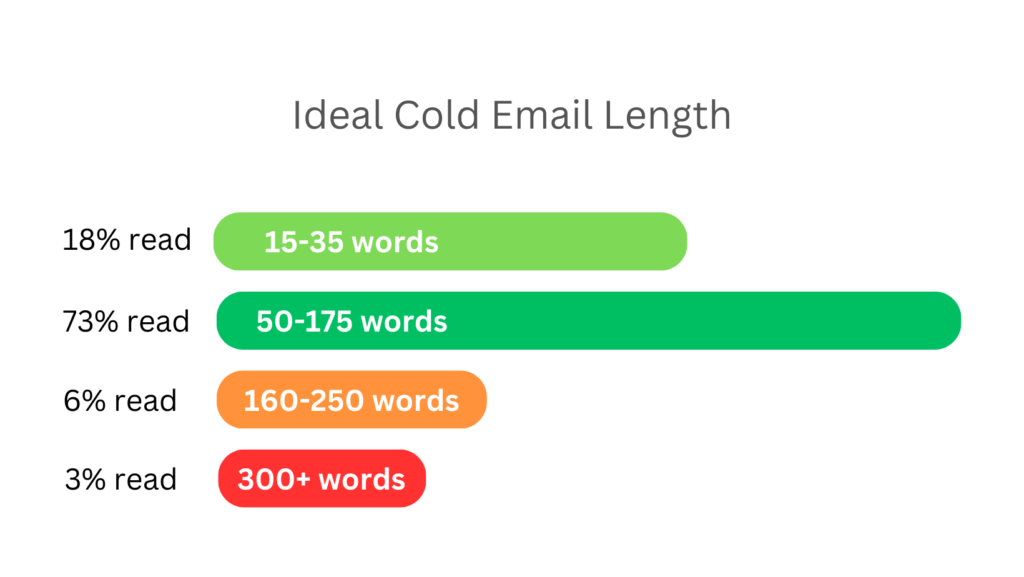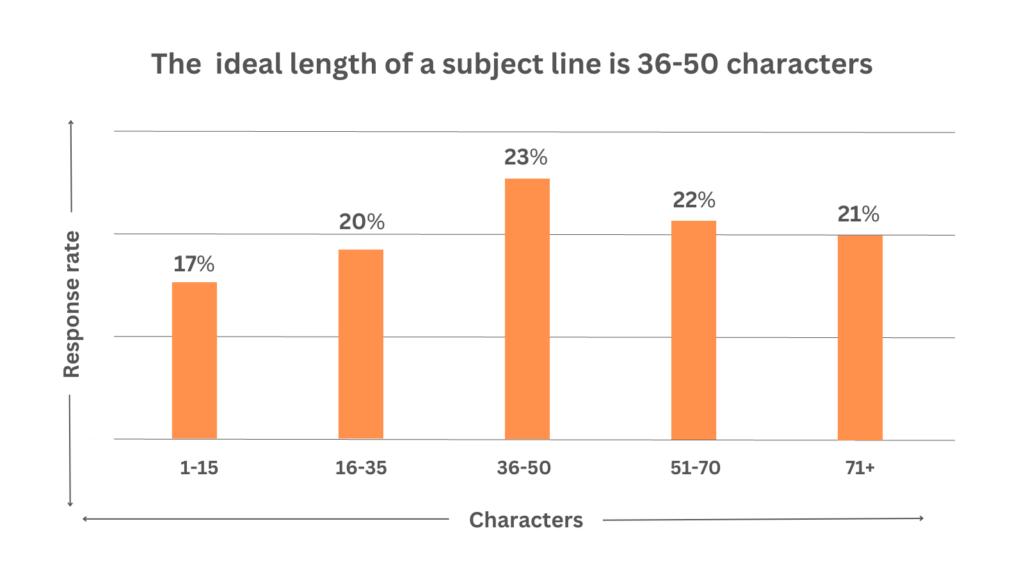When done right, cold emailing can be an effective way to establish valuable connections and drive business growth. However, one of the most common questions that marketers and sales professionals face is: “How long should a cold email be?”
In this blog post, we will explore the ideal length of a cold email and when it’s best to keep it shorter or longer. We’ll also tell you the best practices for writing an attention-grabbing cold email that gets results.
How long should a cold email be?- Ideal length
The ideal length of a cold email can vary based on several factors, including your target audience, the purpose of the email, and the complexity of your message. Boomerang suggests the ideal range of a cold email to be 50-175 words, that is 5-15 lines.

It should not be too short or too long. The reader should not unsee it through halfway.
Here’s a breakdown of when to keep your cold email shorter and when to make it longer
When to Keep It Shorter?
- Quick Introduction: If you’re reaching out to a busy professional or a high-level executive, it’s often best to keep your cold email short and to the point. These individuals have limited time, and a brief introduction that piques their interest is more likely to get a response.
- Clear and Simple Message: When your message is straightforward and doesn’t require extensive explanation, a shorter email is preferred. If you can convey your value proposition concisely, do so.
- Initial Contact: Short cold emails work well for initial outreach. The goal is to establish a connection and prompt a response. You can provide more details in subsequent communications once you’ve piqued their interest.
- Mobile Users: Many people check their emails on mobile devices, where shorter emails are easier to read and digest. Keeping it concise is crucial for mobile responsiveness.
When to Keep It Longer?
- Complex Offers: If your product or service is intricate and needs a detailed explanation, a longer email may be necessary. This allows you to provide all the necessary information to help the recipient understand the value you’re offering.
- Targeting Warm Leads: When you’re reaching out to leads who have already shown some interest or engaged with your content, you have more leeway for a longer email. These recipients may be more open to learning about your offerings in greater detail.
- Educational Content: If you’re sharing educational content, such as whitepapers, case studies, or reports, a longer email can be appropriate. It provides room for explaining the content’s significance and benefits.
- B2B Sales: In the B2B context, where deals are often more complex and involve multiple stakeholders, longer emails can be used to address specific pain points and solutions comprehensively.
- Establishing Credibility: Longer emails can be valuable for building trust and credibility. You can include information about your company’s achievements, customer testimonials, or case studies to show that you’re a reliable and proven solution.
Best practices to write a short cold email:
1. Write Short and Catchy Subject Lines:
The subject line is your first opportunity to grab the recipient’s attention. While discovering how long should a cold email be, it is equally important to pay attention to the length of your subject line too.
Keep it concise, typically under 50 characters, and make it compelling. Use action verbs, intriguing questions, or a clear benefit to entice the recipient to open the email. A well-crafted subject line can significantly improve your email’s open rate.

For example, instead of “Introduction,” consider “Unlock Your Growth Potential.”
2. Use Simple English Language:
Keep your email’s language clear and straightforward. Avoid jargon, complex sentences, or excessive technical details. Your goal is to quickly convey your message and value proposition.
The recipient should easily understand what you’re offering and why it matters to them.
For example, “Our solution streamlines your workflow for increased efficiency” is clearer than “Our innovative workflow optimization tool enhances operational efficiency.”
3. Ask Questions:
Engage the recipient with a question early in the email. Questions can create curiosity and encourage a response. Make sure your questions are relevant to the recipient’s needs or pain points.
This approach encourages interaction and makes the email feel like a personalized conversation.
For example, “Are you struggling to meet your sales targets this quarter?” prompts the recipient to think about their challenges.
4. Present Your Value Proposition:
Clearly and concisely convey the value of your product or service in the email. Explain how it can address the recipient’s pain points or fulfill their needs.
Be specific about the benefits they’ll gain by taking action or engaging with your offer.
For example, “Our software can increase your website traffic by 40% in just 30 days” directly communicates the value.
5. A/B Test Your Email Length:
A/B testing is a crucial strategy to determine what resonates best with your audience. Experiment with different email lengths and formats to see what yields the highest response rates.
Track open rates, click-through rates, and conversion rates to identify which email variations are most effective.
For example, you can test a shorter email against a slightly longer version to see which one generates more responses.
Conclusion:
So, how long should a cold email be? Though most experts suggest keeping it between 5 to 15 lines, there is no one-size-fits-all answer to the question of how long should a cold email be. It largely depends on your audience, the complexity of your offer, and your specific goals.
With the help of a cold email automation tool like SafeMailer, you can experiment with both short and long emails, and track the results to determine what works best for your campaigns. You can personalize your email accordingly and target your audience.

Leave a Reply